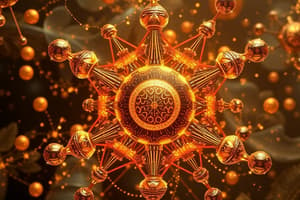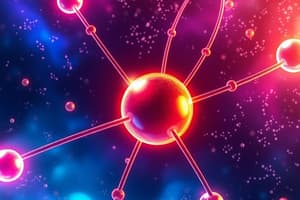Podcast
Questions and Answers
What is the symbol for a proton?
What is the symbol for a proton?
p^+
Where is the proton located in an atom?
Where is the proton located in an atom?
nucleus
What is the charge of a proton?
What is the charge of a proton?
- 1-
- 1+ (correct)
- 2+
- neutral
What is the mass of a proton?
What is the mass of a proton?
What is the symbol for a neutron?
What is the symbol for a neutron?
Where is the neutron located in an atom?
Where is the neutron located in an atom?
What is the charge of a neutron?
What is the charge of a neutron?
What is the mass of a neutron?
What is the mass of a neutron?
What is the symbol for an electron?
What is the symbol for an electron?
Where is the electron located in an atom?
Where is the electron located in an atom?
What is the charge of an electron?
What is the charge of an electron?
What is the mass of an electron?
What is the mass of an electron?
The mass of the atom is due to the __________ and the __________.
The mass of the atom is due to the __________ and the __________.
The volume of the atom is due to the __________.
The volume of the atom is due to the __________.
What does the atomic number represent?
What does the atomic number represent?
What does it mean when an atom is neutral?
What does it mean when an atom is neutral?
How many protons and electrons does a neutral atom of sodium contain?
How many protons and electrons does a neutral atom of sodium contain?
How many protons and electrons does a positive atom of potassium (K^+) contain?
How many protons and electrons does a positive atom of potassium (K^+) contain?
How many protons and electrons does a negative atom of chlorine (Cl^-) contain?
How many protons and electrons does a negative atom of chlorine (Cl^-) contain?
How many protons and electrons does an atom of oxygen with a negative 2 charge (O^2-) contain?
How many protons and electrons does an atom of oxygen with a negative 2 charge (O^2-) contain?
How to determine the composition of an atom?
How to determine the composition of an atom?
How do you calculate the number of neutrons in an atom?
How do you calculate the number of neutrons in an atom?
A neutral atom of magnesium has a mass number of 24. How many protons, neutrons, and electrons does it contain?
A neutral atom of magnesium has a mass number of 24. How many protons, neutrons, and electrons does it contain?
An ion of zinc with a positive 4 charge has a mass number of 65. How many protons, neutrons, and electrons does it contain?
An ion of zinc with a positive 4 charge has a mass number of 65. How many protons, neutrons, and electrons does it contain?
What are isotopes?
What are isotopes?
The two ways to represent composition are __________ and __________.
The two ways to represent composition are __________ and __________.
What is isotopic notation?
What is isotopic notation?
What is the name and number method?
What is the name and number method?
What is the charge on a certain ion with atomic number 16, mass number 33, and 18 electrons?
What is the charge on a certain ion with atomic number 16, mass number 33, and 18 electrons?
What is the identity of an ion with atomic number 16?
What is the identity of an ion with atomic number 16?
How many neutrons does the nucleus of an ion with atomic number 16 and mass number 33 have?
How many neutrons does the nucleus of an ion with atomic number 16 and mass number 33 have?
How many protons does tritium (an isotope of hydrogen) have?
How many protons does tritium (an isotope of hydrogen) have?
What is the mass number of tritium?
What is the mass number of tritium?
What is the charge on a magnesium ion that has 10 electrons?
What is the charge on a magnesium ion that has 10 electrons?
How many neutrons are there in a chromium atom with a mass number of 54?
How many neutrons are there in a chromium atom with a mass number of 54?
Substance E has 29 protons, 28 electrons, and 34 neutrons. Substance F has 29 protons, 27 electrons, and 34 neutrons. What can E and F be categorized as?
Substance E has 29 protons, 28 electrons, and 34 neutrons. Substance F has 29 protons, 27 electrons, and 34 neutrons. What can E and F be categorized as?
What element has 38 protons and 45 neutrons?
What element has 38 protons and 45 neutrons?
What is atomic mass?
What is atomic mass?
How should atomic mass be represented on the periodic table?
How should atomic mass be represented on the periodic table?
How can abundance of isotopes be determined?
How can abundance of isotopes be determined?
What is the formula for mass number?
What is the formula for mass number?
What is the average atomic mass of an element that has isotopes of 49.9461 amu, 51.9405 amu, 52.9407 amu, and 53.9389 amu with respective abundances?
What is the average atomic mass of an element that has isotopes of 49.9461 amu, 51.9405 amu, 52.9407 amu, and 53.9389 amu with respective abundances?
What is the identity of the element with average atomic mass of 51.995?
What is the identity of the element with average atomic mass of 51.995?
Calcium has isotopes with masses of 35 amu, 41 amu, and 40 amu. Which isotope is the most abundant?
Calcium has isotopes with masses of 35 amu, 41 amu, and 40 amu. Which isotope is the most abundant?
What is the average atomic mass of atom X with various isotopes?
What is the average atomic mass of atom X with various isotopes?
Flashcards are hidden until you start studying
Study Notes
Atomic Structure Components
- Proton (p^+): Positively charged particle located in the nucleus; mass approximately 1.673 x 10^-24 grams.
- Neutron (n^0): Neutral particle located in the nucleus; mass approximately 1.673 x 10^-24 grams.
- Electron (e^-): Negatively charged particle found in the electron cloud; mass approximately 9.11 x 10^-28 grams.
Atomic Properties
- Mass of an atom is attributed to protons and neutrons.
- Volume of an atom is determined by the electron cloud.
Atomic Number and Charge
- Atomic Number: Represents the number of protons in an atom; defines the element and dictates the arrangement of elements on the periodic table.
- Atoms are neutral when protons equal electrons. Positive charge occurs when protons exceed electrons, and negative charge occurs when electrons exceed protons.
Example Calculations
- Sodium (Na) has 11 protons and 11 electrons when neutral.
- Potassium ion (K^+) has 20 protons and 19 electrons (one less due to a positive charge).
- Chlorine ion (Cl^-) has 17 protons and 18 electrons (one more due to a negative charge).
- Oxygen ion with a charge of -2 (O^2-) has 8 protons and 10 electrons.
Isotopes and Composition
- Isotopes are variants of the same element differing in neutron count. All isotopes have the same atomic number.
- Examples:
- Hydrogen-1: 1 proton, 0 neutrons
- Hydrogen-2: 1 proton, 1 neutron
- Hydrogen-3: 1 proton, 2 neutrons
- Examples:
- Knowledge of mass number and atomic number enables determination of isotopic composition.
- Number of neutrons calculated as: Mass number - Atomic number.
Elemental Examples
- Magnesium (mass number 24): Contains 12 protons, 12 neutrons, and 12 electrons.
- Zinc ion (Zn^4+) has 30 protons, 35 neutrons, and 26 electrons (4 electrons less).
Atomic Representation
- Isotopic Notation: Indicates mass and atomic number, e.g., Oxygen-16 (16 O, 8).
- Name and Number Method: E.g., Carbon-18 indicates mass number.
Average Atomic Mass and Abundance
- Atomic mass is the weighted average of isotopes; it is not the same as mass number.
- To determine abundance, identify the isotope nearest to the element's average atomic mass.
Calculation of Average Atomic Mass
- For isotopes with varying percentages:
- Calculate average atomic mass using the formula:
- (Mass1 * Abundance1) + (Mass2 * Abundance2) + ...
- Calculate average atomic mass using the formula:
Additional Examples
- Element with 38 protons and 45 neutrons identified as Strontium (Sr).
- Most abundant isotopes typically have masses closest to the average atomic mass on the periodic table.
Additional Concepts in Atomic Structure
- Ions: Atoms with unequal numbers of protons and electrons, categorized by charge (positive or negative).
- Nuclides: Unique nuclear species characterized by proton and neutron counts.
- Nucleons: General term for protons and neutrons within an atomic nucleus.
Studying That Suits You
Use AI to generate personalized quizzes and flashcards to suit your learning preferences.




